 AI
AI
 AI
AI
 AI
AI
UiPath Inc. has always been an unconventional company. It started with humble beginnings as essentially a software development shop. It then caught lightning in a bottle with its computer vision technology and simplification mantra, creating easy-to-deploy software robots for bespoke departments to automate mundane tasks.
The company grew rapidly and was able to go public earlier this year. Consistent with its out-of-the-ordinary approach, while other firms are shutting down travel and physical events, UiPath is moving ahead with Forward IV, its annual user conference next week — with a live audience at the Bellagio in Las Vegas. It’s also “fast forwarding” as a company, determined to lead the charge beyond robotic process automation point tools and execute on a more all-encompassing enterprise automation agenda.
In this Breaking Analysis and ahead of Forward IV, we’ll update you on the RPA market, the financial progress that UiPath has made since its IPO and bring in some ETR customer survey data to contextualize the company’s position in the market and relative to the competition.

First, SiliconANGLE Media’s livestreaming studio theCUBE will be at Forward IV at the Bellagio next week. This live, physical event will primarily be conducted outdoors and you have to be vaccinated to attend. It’s not completely out of the ordinary – John Furrier and theCUBE team covered at the AWS Public Sector Summit this past week. And we were at Mobile World Congress in one of the first big hybrid events of the year in Barcelona. We thought that event would kick off the fall event season in earnest, but the COVID crisis has caused most tech firms to hit the pause button.
Not UiPath. It’s moving ahead and we see a growing trend for smaller VIP events with a virtual component — a topic for another day.
We’ve talked extensively about the productivity challenges and the automation mandate the pandemic has thrust upon us. Now we’ve seen pretty dramatic productivity improvements as remote work kicked in – but it has brought new stresses. According to Qualtrics, 32% of working moms said their mental health has declined since the pandemic hit. Fifteen percent of working dads said the same, by the way. So one has to question the sustainability of the perpetual work day.
Another key point is we see a continuum of automation solutions emerging and we’ll talk about that in some depth today. We’re also seeing tons of mergers and acquisitions across the range of companies in the RPA market.
On the left side of the spectrum there’s Microsoft Corp., which in some ways stands alone in that Azure is becoming ubiquitous as a software-as-a-service, cloud, collaboration and productivity platform. Microsoft is everywhere and in virtually every market – videoconferencing, security, database, cloud, customer relations management, analytics – you name it, and Microsoft is pretty much there.
RPA is no different. With the acquisition of Softomotive last year, Microsoft entered the RPA market in earnest and is penetrating it deeply – as it pertains to personal productivity, building on its software estate.
In the middle of the spectrum we’ve seen even more M&A and that’s defined by the big software giants. Think of this domain as integrated software plays. SAP SE acquired Contextor and Process Insights, ServiceNow Inc. acquired Intellibot, Salesforce bought Servicetrace, and we see Infor Inc. entering the fray. And we would put Pegasystems Inc. in this camp – software companies focused on integrating RPA into their workflows.
This is important because these platforms are entrenched. They’re walled gardens of sorts and complicated with lots of touch points — and frankly harder to automate because of their entrenched legacy.
On the far side of the spectrum are the horizontal automation players and that’s being led by UiPath with Automation Anywhere Inc. as the No. 2 player in this domain. And we would put Blue Prism Group in the mix with the recent M&A announced by Vista Equity, which owns Tibco Software Inc., the integration company.
So with that as background – we’re going to look at how UiPath has performed since we last covered it at its initial public offering and then we’ll bring in Enterprise Technology Research survey data to get the spending view from customers.
Just to emphasize the importance of automation, we want to share this ETR chart shown below:
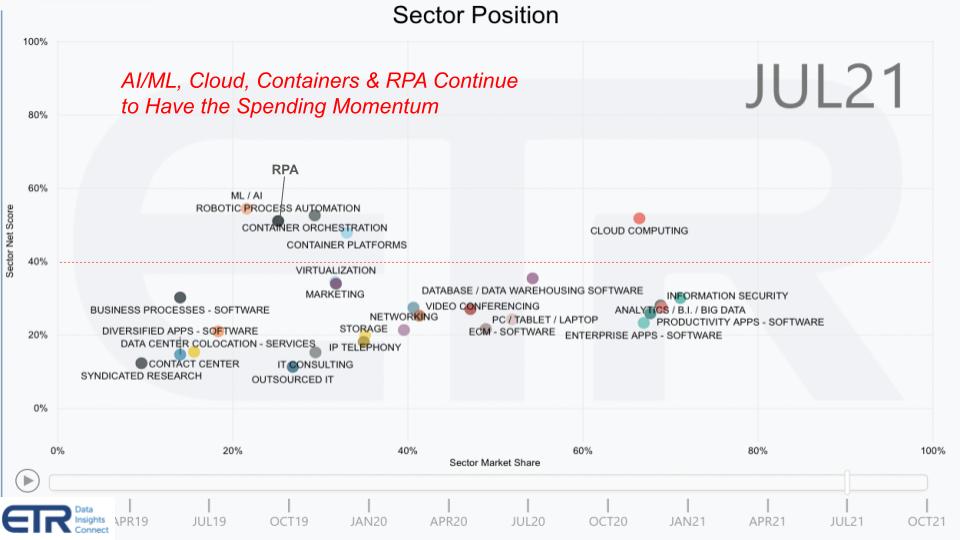
It’s a two-dimensional view with Net Score or spending momentum on the vertical axis and Market Share, which is a proxy for pervasiveness in the survey, on the horizontal axis. Note the red dotted line: It signifies an elevated position on the Net Score vertical axis. This shows every spending segment in the ETR taxonomy. And the four spending categories with the greatest velocity are artificial intelligence, cloud, containers and RPA. And they have topped the charts for a while. They’re the only four categories which have sustained above the 40% line consistently throughout the pandemic and even before.
The impressive thing about cloud, of course, is that it has spending momentum and a large Market Share score. The key point on RPA is that it’s still a nascent market. It has affinity with AI as a means of more intelligently identifying and streamlining process improvements, and so we expect those two to grow together and continue to shift right on the chart.
From UiPath’s vantage point, it pegs its total available market at $60 billion, and the reality is that could be understated.
As we reported from our UiPath S1 analysis we published pre-IPO, the company at the time had annual recurring revenue of $580 million and was growing this at 65% annually. The company at the time had nearly 8,000 customers, 1,000 of which had an ARR in excess of $100,000, and a net revenue retention rate of 145%. Below is the picture six months forward:
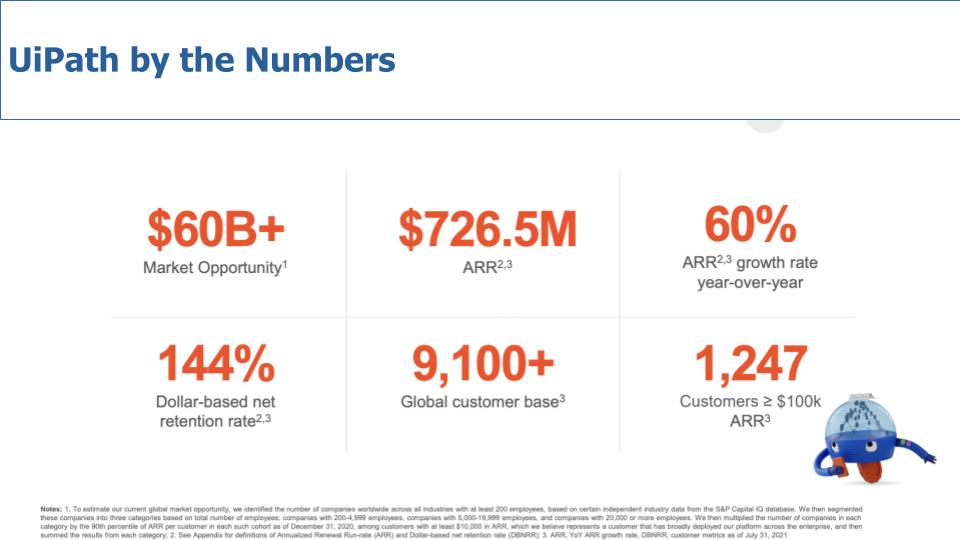
We referenced the $60 billion TAM earlier. ARR for UiPath is now up over $725 million on its way to $1 billion. ARR growth isholding pretty steady at 60%, as is net retention rate, with more than 1,000 new customers and 200 more over $100,000 in ARR. And the company reported a small operating profit, which way exceeded the consensus. Profitability is not shown here and no one seems to care anyway these days – it’s all about growing into that TAM.
Well, that’s a pretty good-looking picture, isn’t it? The company had a beat and raise for the quarter earlier this month. Solid, right?
This is an interesting question. So let’s first look at the stock’s performance on a relative basis.
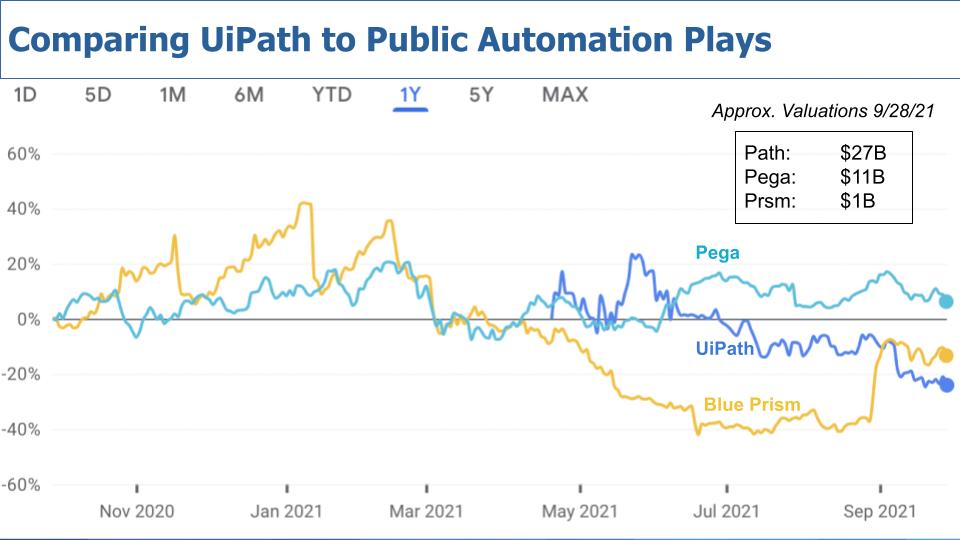
Above we show UiPath’s performance relative to Pegasystems and Blue Prism, the other two publicly traded automation pure plays (sort-of in the case of Pega). So UiPath outperformed post its IPO, but since the early summer, Pega has been the winner, while UiPath decelerated. You see Blue Prism was the laggard until it announced it was in acquisition talks with a couple of private equity firms and the prospects of a bidding war sent that yellow line up.
UiPath has a much higher valuation than Pega and way higher than Blue Prism. Pega is growing revenues nicely at around 40%. We think what’s happening is that the Street simply wants more from the company. Even though UiPath beat and raised, Wall Street is still in the process of getting comfortable with management. The leaders of UiPath are new to the public market game and the company just needs to demonstrate a consistent track record and build trust.
There’s also some education around billings and multiyear contracts that the company addressed on its last earnings call. But the Street was concerned about ARR from new logos. It appears to be slowing sequentially and there’s a notable decline in billings momentum. UiPath Chief Financial Officer Ashim Gupta also addressed this issue on the earnings call, saying the company doesn’t need to trade margin for prepaid multiyear deals given its strong cash position.
And even though we said nobody cares about profitability… well, that’s until you guide for an operating loss when you’ve shown a small profit in recent quarters – then people care. That happened on the earnings call.
So UiPath is a bit of an unknown to the Street and it has a valuation that’s rich at a more than 30 times revenue multiple. So that’s why, in our view, investors are being cautious.
We want to address a dynamic that we’ve seen with these high-growth rocket-ship companies. — something we talked about with Snowflake and we think you’re seeing some of that here with UiPath. It’s a different model in the sense that Snowflake is pure cloud, but we’re talking about concerns around ARR from new logos.
Here’s what’s happening in our view with UiPath. You have a company that started in departments with a small average contract size – maybe $25,000 or $50,000, but not deep six-figure deals – that wasn’t UiPath’s play.
And because the company focused so heavily on simplicity and made it really easy to adopt, customers saw super-fast ROI– breakeven in months. So you very quickly saw expansion to other departments. And then average contract values started to rise and installations expanded within each customer. Then UiPath realized that it had to move beyond being a point tool and it started thinking about a platform and making acquisitions such as ProcessGold. This marked a much deeper expansion into the customer base.
And you see that below in the UiPath investor deck:
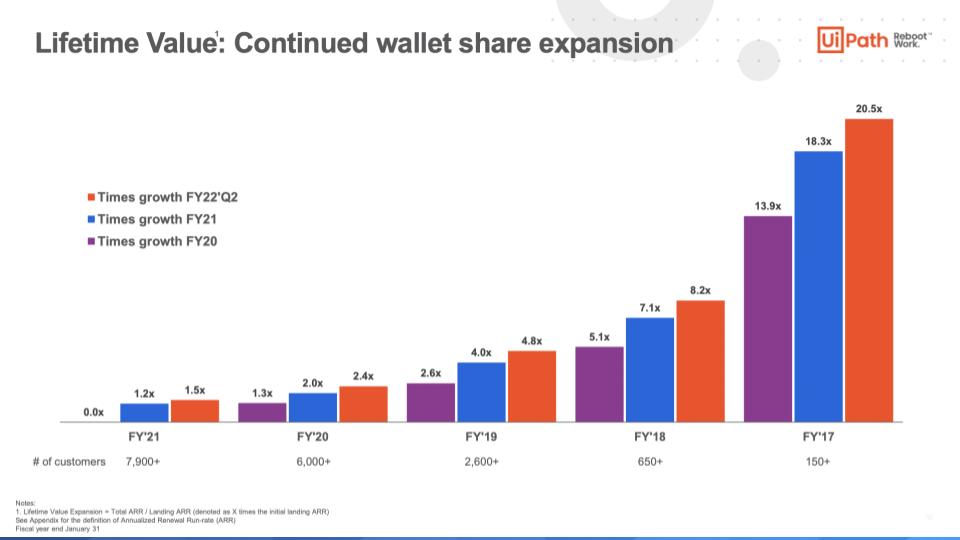
Customers that bought in 2016 and 2017 expanded their spend 13 times, 15 times, 20 times or more. So the lifetime value of the customer is growing dramatically. And because UiPath is focused on simplicity and has a facile freemium model, its customer acquisition costs are likely lower than some of its peers.
So don’t get freaked out about some of those concerns we raised earlier because, just like Snowflake, what’s happening is the company for sure is gaining new customers, maybe just not at the same rate. But don’t miss the forest through the trees – they’re getting more money from their existing customers, which means retention, loyalty and growth.
Speaking of forests, the chart below is the dynamic we’re talking about. It’s an ETR graphic that shows the components of Net Score or Spending momentum for UiPath. By the way, we’re talking about more than 125 responses for UiPath out of a survey of around 1,200 Ns, so it’s meaningful.
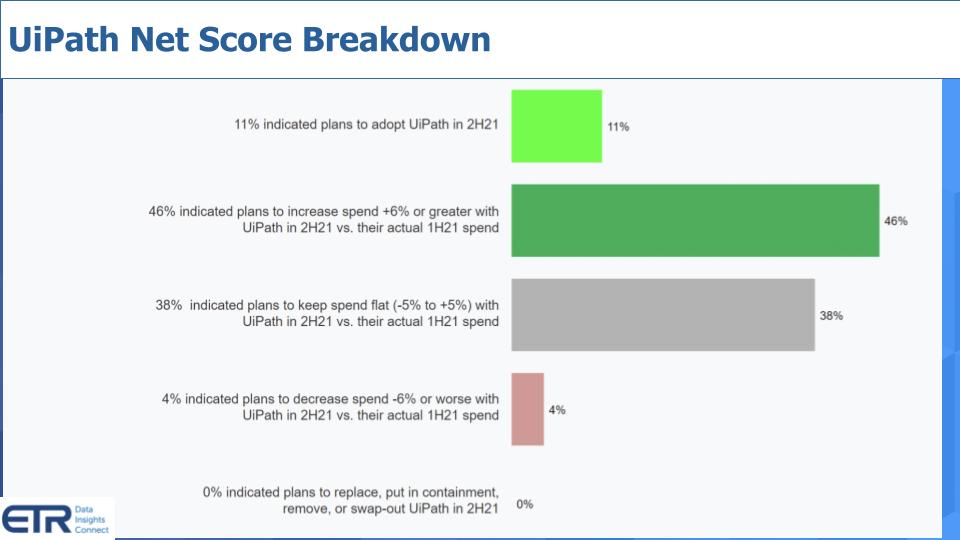
Net Score comprises five components. The lime green is new platform adds. That’s 11% of the UiPath customer mentions. The forest green is the statistical mode and represents customers spending 6% or more in the second half of 2021 relative to the first half. This sector accounts for 46% of the UiPath customers. The gray is flat spend – which is large. The pink or light red is spending -6% or worse – that 4% of the customers.
Look at the bottom bar. That’s churn. There’s no bar there – 0% churn. Churn is the silent killer of SaaS companies. Zero percent defections in the survey. Forty-six percent spending more. That’s the dynamic which is powering UiPath right now and we would rather see this picture over a larger lime green (new adds), smaller forest green (existing spending more) and bigger churn number (bright red that doesn’t exist for UiPath).
This is pretty good. It’s not Snowflake good, but it’s solid.
How does the profile for UiPath compare to its peers?
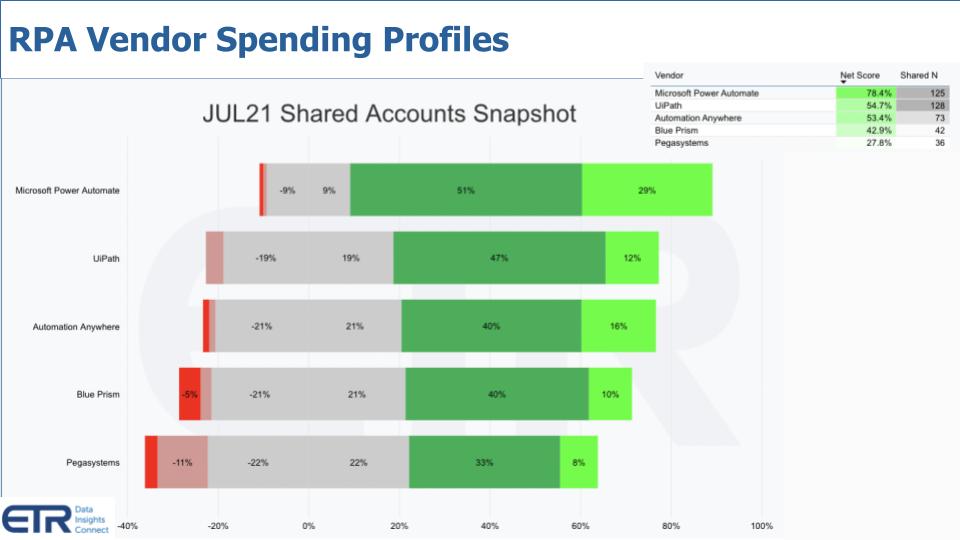
Above we show the same Net Score granularity for Microsoft Power Automate, UiPath, Automation Anywhere, Blue Prism and Pega. As we said earlier, Microsoft is ubiquitous. What can we say about that? But UiPath is right there with a more robust platform. Not to overlook Microsoft – you can’t – but UiPath will tell you it doesn’t compete head-to-head for enterprise automation deals with Microsoft. It may someday, but it’s not a major factor today.
UiPath does, however, compete with Automation Anywhere head-to-head. That company also has a solid picture. Blue Prism is also more than respectable and Pega, even though it’s not a pure play RPA offering, is well into the positive Net Score territory.
Notably, Power Automate, UiPath, AA and Blue Prism all have Net Scores on this chart over 40% (note the table in the upper right). Pega does not, but again we don’t see them as a pure-play RPA vendor. Also note that UiPath has more mentions in the survey than Power Automate, which is meaningful given Microsoft’s ubiquity.
One other notable note: The bright red is defections, and only UiPath is showing zero defections.
OK, so take this as you will, but it’s another data point and one that’s powerful not only for UiPath but for the entire sector.
Below is one of our favorite views that puts the players in context.
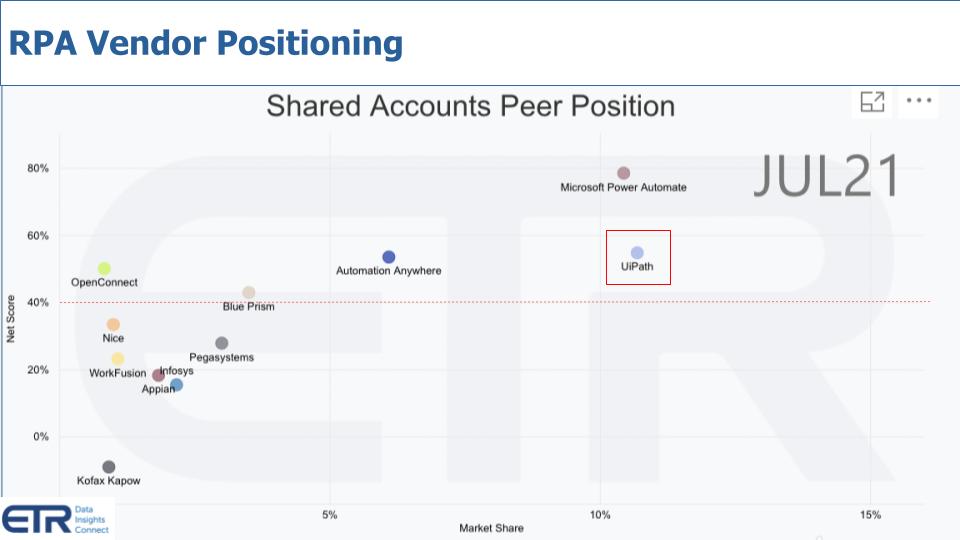
Like the sector chart we showed earlier, this graphic shows Net Score on the vertical axis – that’s spending velocity – and Market Share or pervasiveness on the horizontal axis. You can see, UiPath actually has more presence in the survey than the ever-present Microsoft. Remember this is the July survey. We don’t have full results from the September/October survey yet, but we expect the entire sector will be slightly down as tech spending has moderated somewhat in the second half – as we reported last week – but with strong momentum into 2022.
We don’t expect the picture to change dramatically. UiPath and Power Automate will lead in market presence. Those two plus AA will show strength in spending momentum as will most of the players in the sector.
And we’ll see who comes in above the 40% line.
In summary, we’ll be looking for a few things at the conference:
And finally, we’re excited to participate in a live, in-person event to see what’s working and how hybrid events are evolving. As you know, theCUBE has been doing hybrid events for years and we intend to continue to lead in this regard — and bring you the best real-time information possible from virtual, physical and hybrid events.
Remember we publish each week on Wikibon and SiliconANGLE. These episodes are all available as podcasts wherever you listen. Email david.vellante@siliconangle.com, DM @dvellante on Twitter and comment on our LinkedIn posts.
Also, check out this ETR Tutorial we created, which explains the spending methodology in more detail. Note: ETR is a separate company from Wikibon and SiliconANGLE. If you would like to cite or republish any of the company’s data, or inquire about its services, please contact ETR at legal@etr.ai.
Here’s the full video analysis:
All statements made regarding companies or securities are strictly beliefs, points of view and opinions held by SiliconANGLE media, Enterprise Technology Research, other guests on theCUBE and guest writers. Such statements are not recommendations by these individuals to buy, sell or hold any security. The content presented does not constitute investment advice and should not be used as the basis for any investment decision. You and only you are responsible for your investment decisions.
THANK YOU